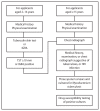Implementation of new TB screening requirements for U.S.-bound immigrants and refugees - 2007-2014
- PMID: 24647399
- PMCID: PMC4584633
Implementation of new TB screening requirements for U.S.-bound immigrants and refugees - 2007-2014
Abstract
For more than two decades, as the number of tuberculosis (TB) cases overall in the United States has declined, the proportion of cases among foreign-born persons has increased. In 2013, the percentage of TB cases among those born outside the country was 64.6%. To address this trend, CDC has developed strategies to identify and treat TB in U.S.-bound immigrants and refugees overseas. Each year, approximately 450,000 persons are admitted to the United States on an immigrant visa, and 50,000-70,000 are admitted as refugees. Applicants for either an immigrant visa or refugee status are required to undergo a medical examination overseas before being allowed to travel to the United States. CDC is the federal agency with regulatory oversight of the overseas medical examination, and panel physicians appointed by the U.S. Department of State perform the examinations in accordance with Technical Instructions (TI) provided by CDC's Division of Global Migration and Quarantine (DGMQ). Beginning in 1991, the algorithm for TB TI relied on chest radiographs for applicants aged ≥15 years, followed by sputum smears for those with findings suggestive of TB; no additional diagnostics were used. In 2007, CDC issued enhanced standards for TB diagnosis and treatment, including the addition of sputum cultures (which are more sensitive than smears) as a diagnostic tool and treatment delivered as directly observed therapy (DOT). This report summarizes worldwide implementation of the new screening requirements since 2007. In 2012, the year for which the most recent data are available, 60% of the TB cases diagnosed were in persons with smear-negative, but culture-positive, test results. The results demonstrate that rigorous diagnostic and treatment programs can be implemented in areas with high TB incidence overseas.
Figures

References
-
- CDC. Decrease in reported tuberculosis cases—United States, 2009. MMWR. 2010;59:289–94. - PubMed
-
- Liu Y, Weinberg MS, Ortega LS, Painter JA, Maloney SA. Overseas screening for tuberculosis in U.S.-bound immigrants and refugees. N Engl J Med. 2009;360:2406–15. - PubMed
-
- Lowenthal P, Westenhouse J, Moore M, Posey DL, Watt JP, Flood J. Reduced importation of tuberculosis after the implementation of an enhanced pre-immigration screening protocol. Int J Tuberc Lung Dis. 2011;15:761–6. - PubMed
-
- Schwartzman K, Oxlade O, Barr RG, et al. Domestic returns from investment in the control of tuberculosis in other countries. N Engl J Med. 2005;353:1008–20. - PubMed
MeSH terms
LinkOut - more resources
Full Text Sources
Medical
Miscellaneous

